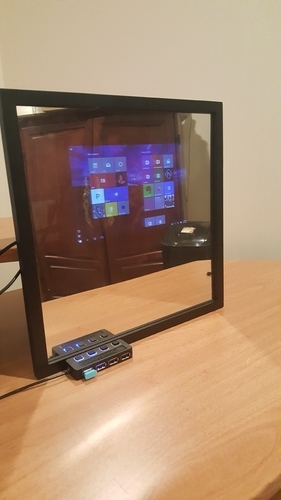
iMirror – DIY Smart Mirror
pinshape
The iMirror is a revolutionary gesture-controlled smart mirror that works with any tablet and even a Raspberry Pi or other device. This innovative project is perfect for college students who want to create a personal computer that can watch Netflix and browse the web without having to get up or type on a keyboard. To build the iMirror, follow these steps: a. Purchase the necessary items as listed in the Bill of Materials. b. Modify the cradle using choice of CAD software to fit your tablet or display perfectly. c. Print the cradle and attach it to the wood backing using wood glue. d. Cut the wood backing to fit the picture frame, then trace the cradle onto the board and cut out the design. e. Make sure the tablet or display fits comfortably inside the cut-out area. f. Place the two-way mirror in the frame followed by the wood backing. g. Use wood glue to attach the cradle to the backing, allowing it to dry for a few minutes before handling the project. h. Slide the tablet or display into place and add foam behind it if necessary. i. Connect the micro-usb to usb adapter and connect the usb extension. j. Connect Myo or Kinect to the iMirror. k. Set up the Myo and Keylemon facial recognition software, which is a fun part of the project! l. Now you have a fully interactive, gesture-controlled smart mirror! Bill of Materials: a. Two-way mirror b. Tablet or LCD display with a Raspberry Pi c. Plywood d. Wood glue e. Micro-usb to usb adapter f. Myo, Kinect, or other gesture control device g. Picture frame h. Keylemon or other facial recognition software (log in without using a keyboard) The iMirror was designed to be a universal smart mirror that works with any tablet and even a Raspberry Pi or other device. The challenge I faced while designing this project was creating a fully interactive smart mirror that would work with any device. I used Autodesk Fusion 360 as my design software to create the 3d printable cradle, which holds the tablet against the two-way mirror while allowing for easy removal. I measured the tablet and drew a "shell" around it in Fusion, then extruded a triangle on top to make a rectangular cradle. I also used a voronoi sketch generator to cut holes for ventilation and ease of access. Custom Section Project: iMirror – DIY Smart Mirror Objective: By completing this project, students will learn about gesture control technology and create an interactive smart mirror. If students use a Raspberry Pi instead of a tablet, they will gain coding skills as well as software design skills. Audiences: Students 10+ and college students (depending on difficulty) Subjects: Engineering and computer science Skills: For students using a Raspberry Pi or other programmable device, intermediate to advanced coding skills are required. Lesson: A) The instructor should print the cradle and purchase the two-way mirror, wood, and adapters. Assemble the mirror as described in the summary, then set up the gesture control and allow students to try out the smart mirror. B) After assembling the mirror and obtaining a Raspberry Pi, find an open-source smart mirror on the internet. Break students into pairs and assign a piece of code to each pair. Allow them to customize the programs to their liking and encourage them to incorporate gesture control into their new program. C) For advanced programmers, have students break into pairs and design a mirror, one to two per pair. Each pair is responsible for writing a certain program. Once every pair has completed their programs, they will distribute their programs to the other groups. From here, there are two options: students can customize the smart mirrors to their liking or work as a class to refine the project. Duration: This project will take less than a day if using a tablet and around 10 weeks if using a Raspberry Pi or other device, depending on coding skills and desired complexity. Assessment: Students will be graded on producing a deliverable and unique features added to their project. If making this a coding project, grading requirements are up to the instructor.
With this file you will be able to print iMirror – DIY Smart Mirror with your 3D printer. Click on the button and save the file on your computer to work, edit or customize your design. You can also find more 3D designs for printers on iMirror – DIY Smart Mirror.
